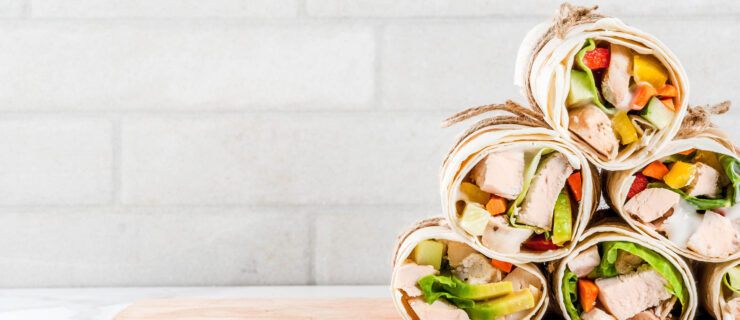Avoid The Dreaded Freshman 15

When it comes to eating at college, there are plenty of ways to fill your plate—some healthy and some not so healthy. “Fried food and sweets are offered in my dining hall all the time,” says Caitlyn Hydeck, a 22-year-old dance major at the University of North Carolina at Greensboro. “Plus I discovered takeout, which requires no work, just a phone call!” With all this newfound freedom, Hydeck realized she could eat any time of day, even late at night. “I was living on my own and felt that I could eat what I wanted as long as I got everything done in my busy schedule,” she says. “As the year progressed, I saw that I was gaining unhealthy weight [16 pounds total], and I didn’t seem to be in the same shape I was before. I was also tired all the time.”
College is the first time that many students, like Hydeck, are responsible for their own diets, and the lack of parental supervision can be overwhelming. “The array of options in the dining hall can lead to choosing high-sugar, high-fat and high-calorie foods more often than at home,” says Alice Bender, nutrition educator at the University of Georgia. “Adjusting to college life can be a challenge since you’re learning to manage classes, studies, student activities and social life in a new way. Healthy eating may not be a student’s first priority.” Here’s how you can create, and keep, a nourishing and beneficial diet without missing barbeques in the quad.
Choosing The Right Foods
Here are some guidelines for loading up your tray in the lunch line. Picture your plate as a pie graph. One-third to one-half should be vegetables, about one-fourth to one-third grains or starch (brown rice, pasta, potato, whole grain bread or cereal) and one-fourth protein (lean red meat, chicken, turkey, egg or beans). Add a nonfat or low-fat dairy serving and some fruit for a well-balanced meal.
Even for students who are health conscious, getting the appropriate amount of nutrients can be difficult for reasons like a lack of variety offered for vegetarians and vegans. Julie Opiel, a 19-year-old dance major at Webster University, was a vegetarian going into freshman year. At home, she ate a variety of protein substitutes for meat, like falafel, beans, tofu and lentils with rice. However, maintaining that lifestyle was difficult at college.
“There’s a vegetarian section of our dining hall, but it’s small,” she says. “It lacks variety at times, so I found myself eating large amounts of pasta, which was too filling before dance class.” Salads did not provide all the nutrients she needed either. She was definitely lacking protein in her diet.
“Being surrounded by pizza never helps a hungry dancer who’s searching for a balance of nutrients in her diet and feeling terrified of the daunting freshmen 15!” Opiel says. She ended up feeling stressed and stuck. “I knew I needed certain foods in my diet, but I also had a meal plan with the dining hall and didn’t want to waste money.” In the end, Opiel decided that she needed to add protein to her diet to be healthy, even if it meant eating the meat that was available in the cafeteria. “I still try to eat vegetarian as much as I can, but now I eat chicken and fish, like tuna.”
Remember, it’s OK to splurge sometimes. If you enjoy fried food, allow yourself to eat it, but no more than twice a week and in moderation. The same goes for dessert. While chocolate chip cookies may be your favorite, “try an oatmeal-raisin one instead, which is somewhat healthier,” says registered dietician Marie Scioscia. “Or share with a friend; you’ll find a few bites will satisfy you. Try to keep it to 200 calories (or one regular-sized cookie) per serving.”
Scheduling Meals
Learning when to eat is just as important as what to eat. During her sophomore year, Hydeck reconstructed her diet to cater to her health needs. “I began eating five to six smaller meals with a main source of protein throughout the day,” she says. “This kept my blood sugar at an even level, and I stayed energized throughout the day. I also lost the extra, unhealthy weight I had gained my freshman year.”
Hydeck had the right idea. “There should be no more than four or five hours between meals,” Scioscia says. “If there is more than that, the body starts to crave sugar.” Also, the more you eat during the active part of your day, the faster you will burn those calories, so eat breakfast as early as possible, she says. “When 8 p.m. comes, that’s when the overeating begins if you haven’t eaten enough during the day.”
Dancers usually tend to think of calories as the enemy, but it’s extremely important for active students to get enough of them. Otherwise your metabolism can slow down, and calories and fat aren’t burned as quickly, Bender says. She suggests having three modest, balanced meals and two to three snacks of fruit, yogurt, nuts or whole grain crackers with cheese.
Making it Work
Here are few pointers to help you make the most of your meals:
-
Build Routines
Habits take about three weeks to create. “Rather than overwhelming yourself, start by learning how to get a good breakfast in, and lock that in for a few weeks,” Scioscia says. “Once you’ve got that down, concentrate on a healthy lunch, and so on.”
-
Be Prepared
“Take a look at the menu one day ahead of time,” Scioscia says. “Sometimes dining halls do a special soup, salad or side, and those are mostly healthy selections.” If you know ahead of time that you will want to choose something higher in fat for one meal (say at a party or celebration), you can balance that in the next meal. “It’s all about planning,” she says. “That takes the stress out of it.”
-
Add Flavor
Jessica York, a 20-year-old dance major at Shenandoah University, made the most of the food that was offered at her school. “Oftentimes, the healthy option is the bland option,” she says. “To make things more flavorful without all the added fat, I would bring my own seasonings or dressings with me to the cafeteria. I had to carry a bigger purse to make it work, but it was worth it!”
-
Avoid Drinking Alcohol
While there are plenty of reasons not to drink alcohol, the fact that it’s all fattening calories without any nutritional value is a major reason for dancers to steer clear. Alcohol can have an impact on your diet in other ways, too. “While drinking, people often don’t make the kinds of food choices they should make,” Bender says. “And for a day or two after drinking several alcoholic beverages, you can have the ‘munchies,’ which may lead to eating more than you need.”
Finding Help
For more personalized information, talk to a nutritionist or counselor at your school’s health center. Or you can check out mypyramid.gov, where you can get an analysis of your diet, plan a daily menu and find an extensive amount of nutrition information.



